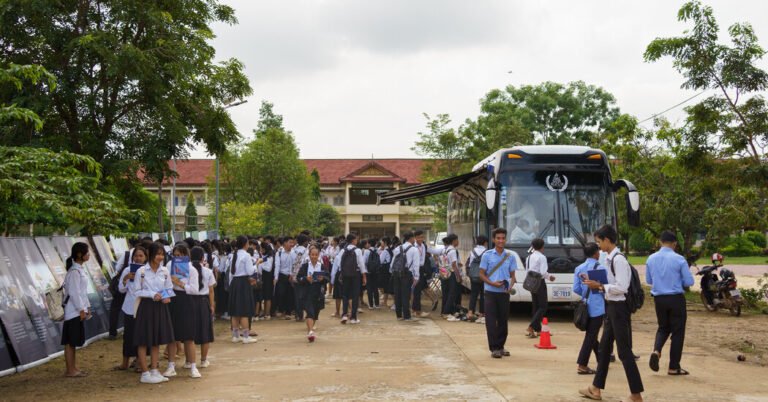
The brand-new bus gleamed as it weaved through rush-hour traffic in Cambodia’s capital. It was headed to a school, bearing a lesson about the country’s darkest period.
About two-thirds of Cambodia’s population is under 30, born a generation or more after the genocidal rule of the Khmer Rouge in the late 1970s. Many of those young people have only a general awareness of its atrocities, which left at least 1.7 million Cambodians dead.
That horrific history has been thoroughly documented, in court documents and at places like the Tuol Sleng Genocide Museum and the killing field in Choeung Ek. But both of these are in the capital, Phnom Penh, and most Cambodians live in the countryside.
The bus’s mission is to bring the history to them. An international effort, it is outfitted with touch screens, laptops and projectors and connected to a vast digital record of the Khmer Rouge’s crimes against humanity, including executions, enslavement, torture, starvation and forced separations.
Its destination on a recent morning was Kampong Speu High School, an hour west of Phnom Penh. There, seven survivors of the Khmer Rouge met the bus at the school to share their stories with students.
Tuch Sakun, 82, wiped tears away with a leopard-print krama, a traditional scarf, as she described the killings of her father and her husband.
“As elders, we need to keep reminding everyone about what happened,” Ms. Tuch Sakun told the students. “You all are so lucky. You have nice clothes. You go to school. You have enough to eat. All we had back then was a black outfit and a red krama.”
The Khmer Rouge came to power in 1975 after a devastating civil war, during which the United States carried out a brutal bombing campaign in Cambodia as part of its war in neighboring Vietnam. Led by Pol Pot, the Communist regime banished people to the countryside, closed schools and ordered everyone, including children, to work toward its stated goal: an agrarian utopia. (Khmer Rouge means Red Khmer; the name refers to the Khmer people, Cambodia’s dominant ethnic group.)
It eviscerated minorities, outlawed money, closed all markets and killed people with skills and education — like doctors and merchants — whom it saw as threats. The Khmer Rouge was toppled by an invading Vietnamese force in 1979, but it continued a guerrilla war from Cambodia’s borderlands into the 1990s.
After years of wrangling, a United Nations-backed court was set up in Phnom Penh in 2006 with a mandate to prosecute top officials from the Khmer Rouge and those most responsible for its crimes. The tribunal, whose official name is the Extraordinary Chambers in the Courts of Cambodia, has spent more than $330 million, but it convicted only three people.
Having completed its prosecutions, the tribunal is now declassifying and digitizing decades’ worth of documents. On the bus, which is an outreach initiative of the tribunal, roughly 975,000 scanned pages, audio records and video files from the tribunal’s 16 years of litigation are accessible.
Perhaps just as important, it brings students together with survivors like Ms. Tuch Sakun. “If the bus didn’t exist, it would be hard for me to reach students and even harder for them to reach me,” she said, touring the interior of the bus with students and other survivors.
Heam Chanmona, an 11th grader, had never before talked about the “Pol Pot time,” as older Cambodians call it, with someone who lived through it.
“If we just read the history of what happened, we really wouldn’t understand how harsh it was back then,” Ms. Heam Chanmona said. “But if we read it, watch it and listen to it on the bus, we will learn so much more about what happened in the past, which we students should know.”
The bus, which started its trips in April, is scheduled to visit schools and colleges in all 25 Cambodian provinces.
Youk Chhang, the executive director of the Documentation Center of Cambodia, a nongovernmental organization that researches and documents the Khmer Rouge period, said any effort to reach communities outside the capital was “a step in the right direction.”
“Genocide education is an entry point for asking questions, researching and thinking critically about events and experiences that were never fully explored by a court of law,” Mr. Youk Chhang said. “Courts are bound by their jurisdiction; classrooms are relatively unbounded.”
Critics say the work of the Khmer Rouge tribunal was impeded by Prime Minister Hun Sen’s government, whose ranks were stacked with former cadres from the regime. Mr. Hun Sen, himself a former Khmer Rouge commander, sought United Nations assistance in setting up the tribunal. He ruled Cambodia for nearly 40 years before stepping down last year and installing his son Hun Manet as prime minister.
Last month, Mr. Hun Manet announced his support for the expansion of the tribunal’s resource center, which is constructing victim consultation rooms, an exhibition hall and a peace park. He also pledged to fund a future research center.
The tribunal will soon launch a website that allows users to search court documents in Khmer script for the first time.
Mr. Youk Chhang, who at 63 has vivid memories of the Khmer Rouge, said that by sharing personal stories from that time, “a survivor can be an educator, who benefits just as much as the student.”
Cambodia’s approach to genocide education is “very localized” and fosters “lots of engagement with people throughout society,” said Alexander Hinton, the director of Rutgers University’s Center for the Study of Genocide and Human Rights.
“If you think about the impact on people, how many people can read a legalistic document?” said Mr. Hinton, who served as an expert witness at the tribunal. “That is where the sort of translation of legal documents to terms that people can understand is absolutely critical. The bus is one way of doing this.”